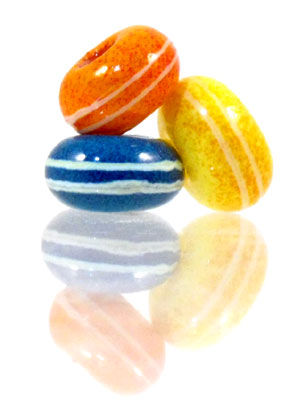
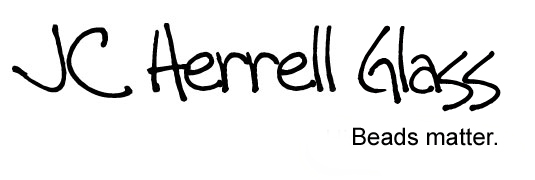
Pulling thicker stringer
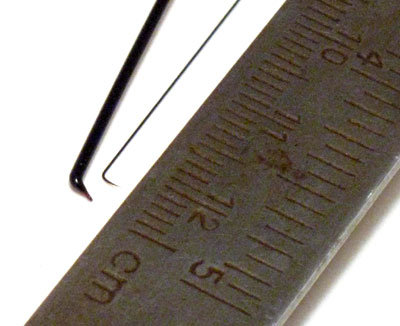
When I refer to "thicker" stringer I mean any stringer
roughly 1mm or larger, which includes almost all
stringers. I will describe very thin stringers in
the next section. Thicker stringers always begin
with a gather of glass.
Below you'll see a few different ways I pull soft glass
stringers about 1-2 mm thick.
In this video I start with an end of a rod that has been
shaped into a long taper from a previous stringer pull.
I allow the gather to drop back onto the rod as it gathers in the
flame. When the gather is the appropriate size
(which depends on the width and length of the stringer
being pulled), I grab the tip of the gather with a
pliers (or tweezers), pause for a moment to let the heat
disperse
evenly, and then pull the stringer out smoothly.
-or-
The following series of photographs show a larger
gather between two rods starting with the joining of the
rods. This method allows for easier, larger
gathers and holds them more securely than pliers
(which tend to shock and break at the end of a larger
pull).

Here I heat the end of one rod until a small gather
forms then use the tapered end of the other rod to
smear the gather back onto the rod. I continue to
push the molten gather with the tip of the 2nd rod until
the two rods are joined.
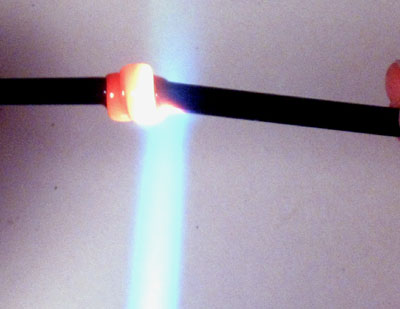
Next I twist the smeared gather to prevent/pop any air
bubbles I may have created.
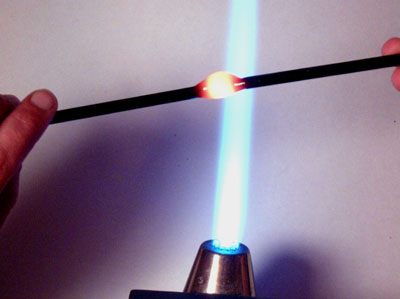
Here I've heated to even the gather between the two
rods. Then I remove it from the flame, allowing the
heat to disperse evenly throughout the gather.
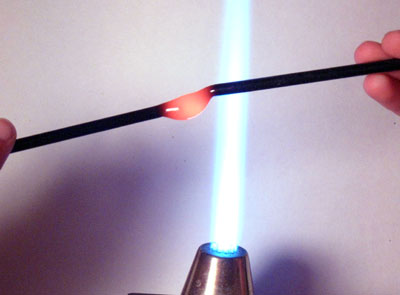
Once the gather has cooled just enough to lose the
white hot glow, I begin to pull the gather apart allowing it
to droop slightly between the two rods.
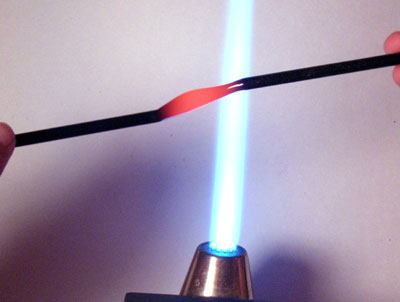
I continue to pull the stringer to the desired
length/width, then pause and hold with slight tension on the
stringer while it cools and hardens.
Then cut with a cool pliers or tweezers. Just a
bit of pressure with a cool tool will cause the
stringer to break right were I grab it.
Pulling a thin stringer
I define a "thin" stringer
as anything small enough to make it hard to measure with
a standard caliper, sometimes called a hair-thin
stringer. Be aware that these stringers are
dangerous! They break easily, are hard to
clean up, and can become embedded in your skin. Use
awareness and caution when making, using and cleaning up
these stringers.
This video shows a close view of a thin stringer pull.
First I heat just the tip of the rod. After the
tip is glowing red, I quickly grab the end with a pliers
(or tweezers) and immediately pull the stringer out of
the hot glass.
This is a wide view of a thin stringer pull so that you
can see the length that comes from just the tip of the
rod.
This a series of photographs showing a thin stringer pull
in more detail:

When the tip of the rod is heated to molten, I immediately
grab and begin to pull the stringer.
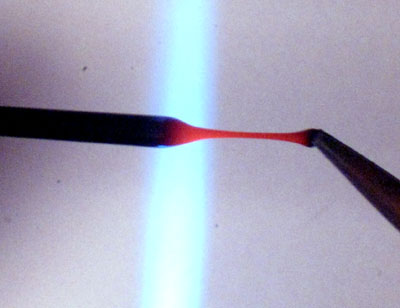
The pull starts out thick but I pull quickly
and...
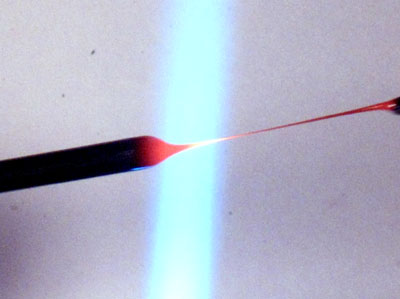
The glass quickly pulls out to supply a long, thin
stringer. Notice that the glass creating the
stringer comes from the tip of the rod as it retains
heat. The stringer cools almost immediately
after being pulled from the rod meaning that if my
pulling motion is smooth, even, and quick, the stringer will be
too.
Color Choices
Any glass is stringer
glass! Some glass just works better for some
applications. Experiment! You'll find you
like some colors of stringers in certain situations and
other colors in other situations - that's one of the
joys of stringer! Here are a few notes about
specific colors and variations of stringer:
Intense black: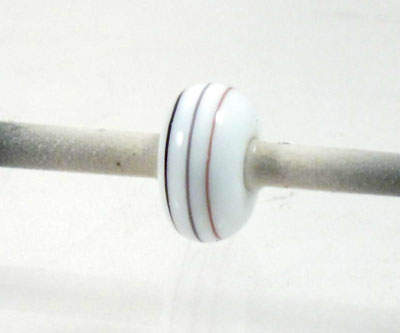
Black glass is actually a dark transparent color. If you are using thick stringer, the standard black rod will work just fine. However that same standard black rod will produce transparent thin stringers. To solve this problem most manufacturers of soft glass offer a dense black, an intense black or another strongly saturated black rod. The intense black will produce a strong black for thin stringers, but will still appear transparent in the thinnest of stringers, which is why I like Effetre's dark silver plum.
The picture to the right shows three very thin lines drawn in
the following colors from left to right: dark
silver plum, intense black, regular black. Notice
that both blacks are washed out in such little quantity.

Dark silver plum:
Dark silver plum (DSP) #275, made by Effetre, is a
great glass for hair-thin stringers. This is a
104 COE metallic glass with an opaque dark purple base that will
produce a number of metallic effects from an oil-slicked
look to gunmetal silver. The metals and dark base
in this glass allow thin stringers of this glass to
remain opaque. DSP is the opposite of a reduction
glass; it's important to work this glass
in a neutral or oxidized flame (added oxygen and/or reduced
propane) so that metals will rise and remain at the
surface of the glass.
Add stuff to your stringer:
1- Silver is a popular addition to stringer, specifically silvered ivory stringer. Try wrapping the end of a dark ivory rod in a sheet of silver foil or leaf, burnish to smooth and adhere the silver, heat to form a gather and then pull into stringer. The result is a wonderful natural looking line.
2- Add reduction or color streaks to your stringer by rolling your gather in frit a few times before pulling your stringer (be sure to reheat the gather between rolls to maintain heat and fuse the frit from the last roll). Use a reduction frit to create reduction stringer. Use tone-on-tone color to create subtle streaky effects.
3- My favorite addition to stringer is enamel! Roll your gather in enamel several times and pull. You'll notice that the enamel makes the glass stiff and more difficult to pull. I often pinch a handle on the tip of the gather with my pliers, reheat the center of the gather and then pull the stringer. Heavily enameled stringer will create waxy color streaks while lightly enameled stringers create dynamic webbing effects. Enameled stringers are also noticeably stiffer making controlling them in the heat a bit easier, but they are brittle so be sure to store and use them with care. A few ways I use enameled stringer:

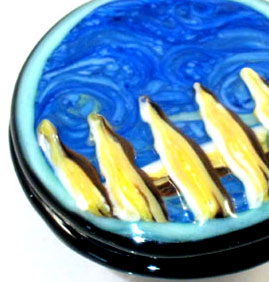
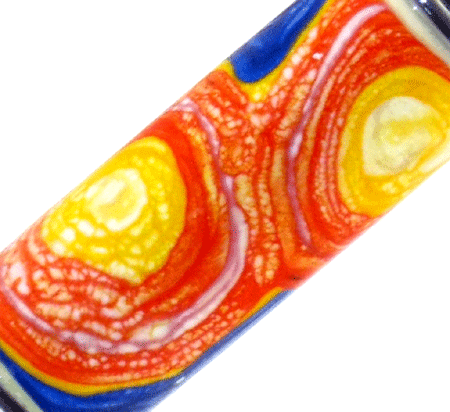

Did you find this information helpful? Will it enhance your work? Any donation is appreciated!
Questions or comments? Let me know so I can make these tutorials even more user friendly!
The Joy of Stringer Menu www.jcherrell.com Purchase work
Written and
photographed by JC Herrell; Copywright, JC Herrell 2010











